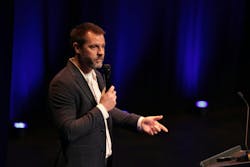FireFusion 2025: Connected Vehicles, AI Will Transform Emergency Vehicle Response
A year ago, Marcus Claycomb spoke at FireFusion 2024 about the benefits of artificial intelligence (AI) during emergency response. This year, Claycomb was joined by colleague Kjeld Linstead, to futher last year's discussion and bring the audience's awareness to the next level.
The session, "The Future of Fire Response: Achieving Efficiencies with Connected Vehicles & AI" dug into AI with fire department emergency response, showing the potential to increase safety and decrease response times while offering data collection and retention.
Creating context
Lindsted, group manager for Panasonic's Connected Vehicles, opened the session emphasizing that there is a progression of how to use AI. To use AI to its fullest capability and impact the agency, there needs to be a connection between context of the data and making the output meaningful. It’s the Internet of Things (IoT) stage that allows connection between the “edge” technologies that are implemented in everyday life, but where do you start?
The idea is to connect the data that is out in the world and pull it back to where the fire service can sit on it and look at it. That’s called “big data,” Linsted said, and is the middle of the progression of getting AI to be truly meaningful.
Taking the step requires asking the question, "how do we build AI models against that information?" If that “big data” is not there, then those models can’t be built, he said. To build out those models, users need to understand the context of the entire operating environment.
One of the biggest problems with starting this progression, Claycomb pointed out, was the multiple silos of information that don’t talk to each other or play well when integrated. The solution to that is the dashboards being created to pool together all the silos.
“I think setting that context is really important, because you understand how these tools start to operate and the meaning that they can have,” said Lindsted.
Most of the agencies have the information, but it’s separated into the silos of fleet tracking in a spreadsheet, maintenance logged in its shop application, maps data in ArcGIS, vehicle locations in CAD and telematics data sets.
There are no connection or context between the information, making the AI models hard to build. That’s where Claycomb and Lindsted’s two-prong approach of connecting your equipment and getting more from existing hardware comes into play.
“This isn’t about procuring more connectivity. This isn’t about new technology. It’s about taking advantage of what you’ve already got and pulling it together into a meaningful context,” said Lindsted.
Claycomb and Lindsted discussed some use cases that would be possible as the process of IoT progresses.
Use cases
Driver and pedestrian alerts
How do we create a picture that’s good enough to give us a digital layer of lights and sirens on top of fleet operations and push that out to the public, they asked.
There is already a base set of alerts on Google Maps and Waze of police checkpoints, crashes, flooding and other roadway hazards. The start to that question is getting your vehicle connected so that official law enforcement and fire department specific - or authoritative data - can be added to the public data banks to let drivers have additional contexts.
Emergency vehicle preemption
The goal is providing first responders with green lights. However, the challenge with traffic preemption was the cost and complexity. There were multiple devices that were necessary to add into the infrastructure and it was hard to track the usage. There wasn’t a connection between the response data and traffic signal data, but the solution is now in the cloud.
Starting to make decisions at the cloud level allows for validation of the data, which then opens reporting on that data. That answers questions, such as did it work, when was the call placed, by who and what vehicles were coming from which direction? Being able to have those answers creates an opportunity for AI to be implemented for better efficiency.
Instead of traffic preemption being applicable to just the next intersection, it would be applicable to the entire route during emergency response and push that information to civilian vehicles.
Emergency vehicle alerts
The first case was focused on was pushing that information out to the public, but this one has to do with relaying that information in between agencies.
If you have different agencies responding to the same emergency, they are all expecting to have the right of way, but having the alerts gives the chance for the first responders to know where each other is and get to the scene safer.
Telematics
How do you manage your fleet?
A lot of agencies will manually go out to write down how many miles are on the apparatus each week and track the maintenance manually through a survey. They pointed to the issue that the transfer of data was lost. When you communicate data through multiple channels, there becomes a risk of the data getting corrupted and misinterpreted. It also just takes up time.
Being able to plug that data into an AI model and have it digitally lowers cost, creates less risk and minimizes time.
Situational awareness
How do you create context around the entire operating picture?
The two discussed how there are systems that can create that context but may not have the complete picture of what is happening. For example, the questions of what condition the vehicle is currently in, where the vehicles are, are the lights and sirens active, etc., may not be answered with those original systems.
Pulling that information digitally from the vehicles into connected platforms creates that situational awareness and then allows for analyzation of the data after the fact when moved into an AI model.
Claims data collection
How can the agency protect itself?
This use case focused on the horror stories from the agency’s perspective of emergency response in terms of responding to an emergency and having a collision with the public. If that data collection is there, then it allows the agency to look back and see what exactly happened before and during the collision.
“That data is sandboxed. In an AI instance, it is within the sandbox of your agency. It’s not going out to the web. It’s not going out to the general public, and they still protect and secure your environment. You’re just using it in-house,” said Claycomb.
Panasonic’s direction
After Claycomb and Lindsted talked through the use cases, they mentioned what Panasonic is doing to combat this complex topic. They are building on the modularity that has been engineered into the hardware platform that Panasonic manufactures. They want to take that next step into the data layer by connection all of those “edge” technologies.
“It’s going to augment your operations to take you through that journey from getting all these things at the edge connected. Let’s collect the data into a big data ecosystem and some kind of endless application of AI tools on top of it,” said Lindsted.
It’s about leveraging what you already have and cleaning up and simplifying the environment inside of the vehicle.
“We developed the technology to do A, B and C, and when we deploy it in the field, you will find E, F and G ways to use it specifically to your agency. The opportunities will be pretty much limited to your creativity,” said Claycomb.
“What we are encouraging agencies to do is to work through this,” said Lindsted. “There are concrete things that we can do now to make it worthwhile. Connecting your vehicle, connecting your first responder, pulling your devices together, putting that data into a joint database where it can actually make sense for you and then starting to build some early AI tools on top of it. That sets us up to be able to take advantage of whatever it is that comes down the road in the future.”
About the Author

Ryan Baker
Ryan Baker is a writer and associate editor with prior experiences in online and print production. Ryan is an associate editor for Firehouse with a master's degree in sciences of communication from the University of Wisconsin-Whitewater. He recently completed a year of teaching Intro to Public Speaking at UW-Whitewater, as part of his graduate program. Ryan acquired his bachelor's degree in journalism in 2023 from UW-Whitewater, and operates currently out of Minneapolis, MN. Baker, also writes freelances for the Ultimate Frisbee Association (UFA) in his free time, while also umpiring baseball for various ages across the Twin Cities Metro Area.

